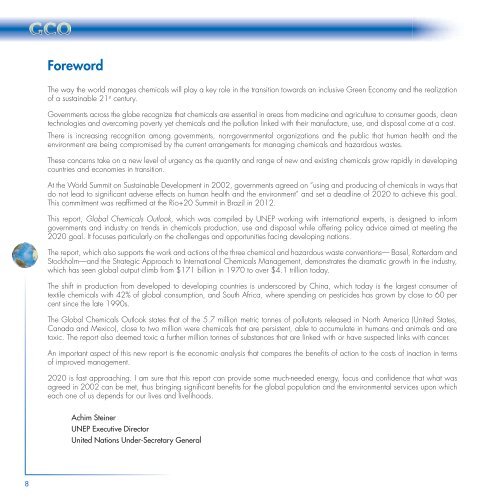Global Chemicals Outlook - UNEP
Global Chemicals Outlook - UNEP
Global Chemicals Outlook - UNEP
You also want an ePaper? Increase the reach of your titles
YUMPU automatically turns print PDFs into web optimized ePapers that Google loves.
8<br />
Foreword<br />
The way the world manages chemicals will play a key role in the transition towards an inclusive Green Economy and the realization<br />
of a sustainable 21 st century.<br />
Governments across the globe recognize that chemicals are essential in areas from medicine and agriculture to consumer goods, clean<br />
technologies and overcoming poverty yet chemicals and the pollution linked with their manufacture, use, and disposal come at a cost.<br />
There is increasing recognition among governments, non-governmental organizations and the public that human health and the<br />
environment are being compromised by the current arrangements for managing chemicals and hazardous wastes.<br />
These concerns take on a new level of urgency as the quantity and range of new and existing chemicals grow rapidly in developing<br />
countries and economies in transition.<br />
At the World Summit on Sustainable Development in 2002, governments agreed on “using and producing of chemicals in ways that<br />
do not lead to signifi cant adverse effects on human health and the environment” and set a deadline of 2020 to achieve this goal.<br />
This commitment was reaffi rmed at the Rio+20 Summit in Brazil in 2012.<br />
This report, <strong>Global</strong> <strong>Chemicals</strong> <strong>Outlook</strong>, which was compiled by <strong>UNEP</strong> working with international experts, is designed to inform<br />
governments and industry on trends in chemicals production, use and disposal while offering policy advice aimed at meeting the<br />
2020 goal. It focuses particularly on the challenges and opportunities facing developing nations.<br />
The report, which also supports the work and actions of the three chemical and hazardous waste conventions— Basel, Rotterdam and<br />
Stockholm—and the Strategic Approach to International <strong>Chemicals</strong> Management, demonstrates the dramatic growth in the industry,<br />
which has seen global output climb from $171 billion in 1970 to over $4.1 trillion today.<br />
The shift in production from developed to developing countries is underscored by China, which today is the largest consumer of<br />
textile chemicals with 42% of global consumption, and South Africa, where spending on pesticides has grown by close to 60 per<br />
cent since the late 1990s.<br />
The <strong>Global</strong> <strong>Chemicals</strong> <strong>Outlook</strong> states that of the 5.7 million metric tonnes of pollutants released in North America (United States,<br />
Canada and Mexico), close to two million were chemicals that are persistent, able to accumulate in humans and animals and are<br />
toxic. The report also deemed toxic a further million tonnes of substances that are linked with or have suspected links with cancer.<br />
An important aspect of this new report is the economic analysis that compares the benefi ts of action to the costs of inaction in terms<br />
of improved management.<br />
2020 is fast approaching. I am sure that this report can provide some much-needed energy, focus and confi dence that what was<br />
agreed in 2002 can be met, thus bringing signifi cant benefi ts for the global population and the environmental services upon which<br />
each one of us depends for our lives and livelihoods.<br />
Achim Steiner<br />
<strong>UNEP</strong> Executive Director<br />
United Nations Under-Secretary General

















